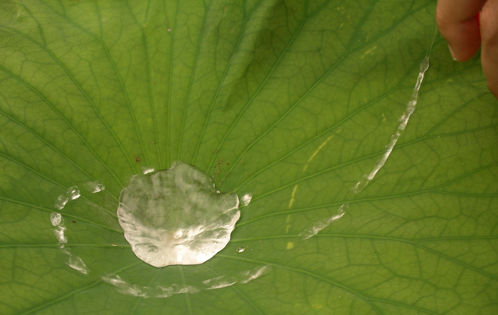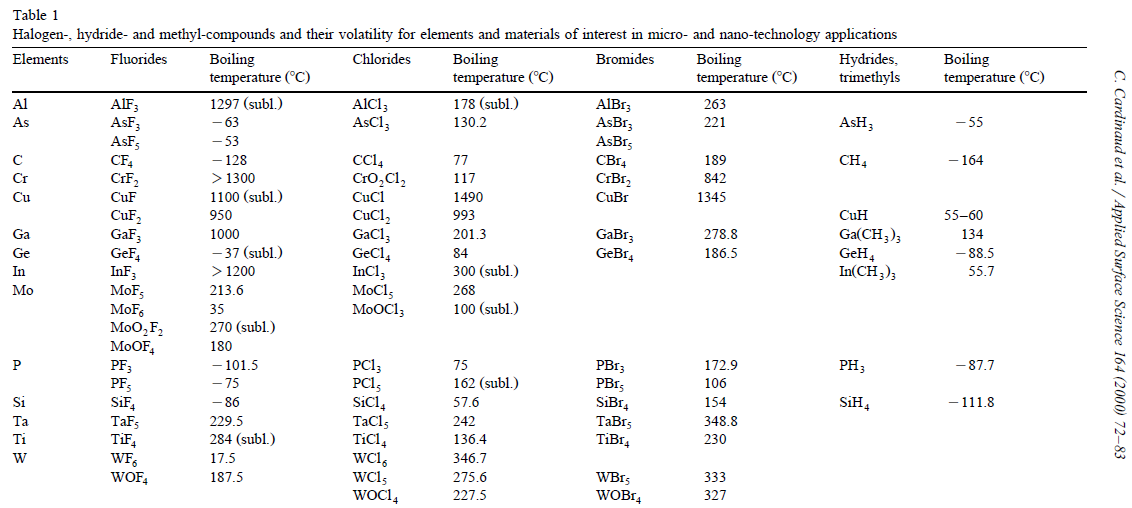|
Self-cleaning Surfaces
Self-cleaning surfaces are a class of materials with the inherent ability to remove any debris or bacteria from their surfaces in a variety of ways. The self-cleaning functionality of these surfaces are commonly inspired by natural phenomena observed in lotus leaves, gecko feet, and water striders to name a few. The majority of self-cleaning surfaces can be placed into three categories: # superhydrophobic # superhydrophilic # photocatalytic. History The first instance of a self-cleaning surface was created in 1995. Paz et al. created a transparent titanium dioxide (TiO2) film that was used to coat glass and provide the ability for the glass to self-clean. The first commercial application of this self-cleaning surface, Pilkington Activ, was developed by Pilkington glass in 2001. This product implements a two-stage cleaning process. The first stage consists of photocatalysis of any fouling matter on the glass. This stage is followed by the glass becoming superhydrophilic and allo ... [...More Info...] [...Related Items...] OR: [Wikipedia] [Google] [Baidu] |
Lotus Effect
The lotus effect refers to self-cleaning properties that are a result of ultrahydrophobicity as exhibited by the leaves of ''Nelumbo'', the lotus flower. Dirt particles are picked up by water droplets due to the micro- and nanoscopic architecture on the surface, which minimizes the droplet's adhesion to that surface. Ultrahydrophobicity and self-cleaning properties are also found in other plants, such as ''Tropaeolum'' (nasturtium), ''Opuntia'' (prickly pear), ''Alchemilla'', cane, and also on the wings of certain insects. The phenomenon of ultrahydrophobicity was first studied by Dettre and Johnson in 1964 using rough hydrophobic surfaces. Their work developed a theoretical model based on experiments with glass beads coated with paraffin or Polytetrafluoroethylene, PTFE fluorotelomer, telomer. The self-cleaning property of ultrahydrophobic micro-nanotechnology, nanostructured surfaces was studied by Wilhelm Barthlott and Ehler in 1977, who described such self-cleaning and ultr ... [...More Info...] [...Related Items...] OR: [Wikipedia] [Google] [Baidu] |
Plasma Etching
Plasma etching is a form of plasma processing used to fabricate integrated circuits. It involves a high-speed stream of glow discharge (plasma) of an appropriate gas mixture being shot (in pulses) at a sample. The plasma source, known as etch species, can be either charged (ions) or neutral (atoms and radicals). During the process, the plasma generates volatile etch products at room temperature from the chemical reactions between the elements of the material etched and the reactive species generated by the plasma. Eventually the atoms of the shot element embed themselves at or just below the surface of the target, thus modifying the physical properties of the target. Mechanisms Plasma generation A plasma is a high energetic condition in which a lot of processes can occur. These processes happen because of electrons and atoms. To form the plasma electrons have to be accelerated to gain energy. Highly energetic electrons transfer the energy to atoms by collisions. Three different pr ... [...More Info...] [...Related Items...] OR: [Wikipedia] [Google] [Baidu] |
Photolithography
In integrated circuit manufacturing, photolithography or optical lithography is a general term used for techniques that use light to produce minutely patterned thin films of suitable materials over a substrate, such as a silicon wafer, to protect selected areas of it during subsequent etching, deposition, or implantation operations. Typically, ultraviolet light is used to transfer a geometric design from an optical mask to a light-sensitive chemical (photoresist) coated on the substrate. The photoresist either breaks down or hardens where it is exposed to light. The patterned film is then created by removing the softer parts of the coating with appropriate solvents. Conventional photoresists typically consists of three components: resin, sensitizer, and solvent. Photolithography processes can be classified according to the type of light used, such as ultraviolet, deep ultraviolet, extreme ultraviolet, or X-ray. The wavelength of light used determines the minimum feature si ... [...More Info...] [...Related Items...] OR: [Wikipedia] [Google] [Baidu] |
Polyethylene Glycol
Polyethylene glycol (PEG; ) is a polyether compound derived from petroleum with many applications, from industrial manufacturing to medicine. PEG is also known as polyethylene oxide (PEO) or polyoxyethylene (POE), depending on its molecular weight. The structure of PEG is commonly expressed as H−(O−CH2−CH2)n−OH. Uses Medical uses * Pharmaceutical-grade PEG is used as an excipient in many pharmaceutical products, in oral, topical, and parenteral dosage forms. * PEG is the basis of a number of laxatives (as ''MiraLax''). Whole bowel irrigation with polyethylene glycol and added electrolytes is used for bowel preparation before surgery or colonoscopy. * PEG is used in medicines for treating disimpaction and maintenance therapy for children with constipation. * When attached to various protein medications or drug carriers, polyethylene glycol of suitable length slows down their clearance from the blood. * The possibility that PEG could be used to fuse axons is being ... [...More Info...] [...Related Items...] OR: [Wikipedia] [Google] [Baidu] |
Glass Transition Temperature
The glass–liquid transition, or glass transition, is the gradual and reversible transition in amorphous materials (or in amorphous regions within semicrystalline materials) from a hard and relatively brittle "glassy" state into a viscous or rubbery state as the temperature is increased. ISO 11357-2: Plastics – Differential scanning calorimetry – Part 2: Determination of glass transition temperature (1999). An amorphous solid that exhibits a glass transition is called a glass. The reverse transition, achieved by supercooling a viscous liquid into the glass state, is called vitrification. The glass-transition temperature ''T''g of a material characterizes the range of temperatures over which this glass transition occurs (as an experimental definition, typically marked as 100 s of relaxation time). It is always lower than the melting temperature, ''T''m, of the crystalline state of the material, if one exists. Hard plastics like polystyrene and poly(methyl methacrylate) are u ... [...More Info...] [...Related Items...] OR: [Wikipedia] [Google] [Baidu] |
Polydimethylsiloxane
Polydimethylsiloxane (PDMS), also known as dimethylpolysiloxane or dimethicone, belongs to a group of polymeric organosilicon compounds that are commonly referred to as silicones. PDMS is the most widely used silicon-based organic polymer, as its versatility and properties lead to many applications. It is particularly known for its unusual rheological (or flow) properties. PDMS is optically clear and, in general, inert, non-toxic, and non-flammable. It is one of several types of silicone oil (polymerized siloxane). Its applications range from contact lenses and medical devices to elastomers; it is also present in shampoos (as it makes hair shiny and slippery), food (antifoaming agent), caulk, lubricants and heat-resistant tiles. Structure The chemical formula of PDMS is , where ''n'' is the number of repeating monomer units.Mark, J. E.; Allcock, H. R.; West, R. “Inorganic Polymers” Prentice Hall, Englewood, NJ: 1992. . Industrial synthesis can begin from dimethyldichloro ... [...More Info...] [...Related Items...] OR: [Wikipedia] [Google] [Baidu] |
Soft Lithography
In technology, soft lithography is a family of techniques for fabricating or replicating structures using "elastomeric stamps, molds, and conformable photomasks". It is called "soft" because it uses elastomeric materials, most notably PDMS. Soft lithography is generally used to construct features measured on the micrometer to nanometer scale. According to Rogers and Nuzzo (2005), development of soft lithography expanded rapidly from 1995 to 2005. Soft lithography tools are now commercially available. Types * PDMS stamp * Microcontact printing * Multilayer soft lithography Advantages Soft lithography has some unique advantages over other forms of lithography (such as photolithography and electron beam lithography). They include the following: *Lower cost than traditional photolithography in mass production *Well-suited for applications in biotechnology *Well-suited for applications in plastic electronics *Well-suited for applications involving large or nonplanar (nonflat) ... [...More Info...] [...Related Items...] OR: [Wikipedia] [Google] [Baidu] |
Aquarius Remigis
''Aquarius remigis'', known as the common water strider, is a species of aquatic insect, aquatic Hemiptera, bug. It was formerly known as ''Gerris remigis'', but the subgenus ''Aquarius'' was elevated to generic rank in 1990 on the basis of phylogenetic analysis. ''Aquarius remigis'' is found throughout North America, but is most prevalent in the mid-west of the United States.Maps Description ''Aquarius remigis'' grows slightly longer than .5 inches, and is dark brown to black in colour. It has a sharp Rostrum (anatomy), rostrum that it uses to pierce the body of its prey and suck out the insides. Behaviour They normally continue to move to avoid being eaten by predators. It has good vision, and can row quickly over the surface of the water. It uses its front legs to seize its prey. During breeding season, this species can communicate with potential mates by sending ripples over on the surface of the water. Adult females normally lay their eggs on plant stems at the water's e ... [...More Info...] [...Related Items...] OR: [Wikipedia] [Google] [Baidu] |
Nepenthes
''Nepenthes'' () is a genus of carnivorous plants, also known as tropical pitcher plants, or monkey cups, in the monotypic family Nepenthaceae. The genus includes about 170 species, and numerous natural and many cultivated hybrids. They are mostly liana-forming plants of the Old World tropics, ranging from South China, Indonesia, Malaysia, and the Philippines; westward to Madagascar (two species) and the Seychelles (one); southward to Australia (four) and New Caledonia (one); and northward to India (one) and Sri Lanka (one). The greatest diversity occurs on Borneo, Sumatra, and the Philippines, with many endemic species. Many are plants of hot, humid, lowland areas, but the majority are tropical montane plants, receiving warm days but cool to cold, humid nights year round. A few are considered tropical alpine, with cool days and nights near freezing. The name "monkey cups" refers to the fact that monkeys were once thought to drink rainwater from the pitchers. Description ''N ... [...More Info...] [...Related Items...] OR: [Wikipedia] [Google] [Baidu] |
Contact Angle
The contact angle is the angle, conventionally measured through the liquid, where a liquid–vapor interface meets a solid surface. It quantifies the wettability of a solid surface by a liquid via the Young equation. A given system of solid, liquid, and vapor at a given temperature and pressure has a unique equilibrium contact angle. However, in practice a dynamic phenomenon of contact angle hysteresis is often observed, ranging from the advancing (maximal) contact angle to the receding (minimal) contact angle. The equilibrium contact is within those values, and can be calculated from them. The equilibrium contact angle reflects the relative strength of the liquid, solid, and vapour molecular interaction. The contact angle depends upon the medium above the free surface of the liquid, and the nature of the liquid and solid in contact. It is independent of the inclination of solid to the liquid surface. It changes with surface tension and hence with the temperature and purity of t ... [...More Info...] [...Related Items...] OR: [Wikipedia] [Google] [Baidu] |
Wilhelm Barthlott
Wilhelm Barthlott (born 1946 in Forst, Germany) is a German botanist and biomimetic materials scientist. His official botanical author citation is Barthlott. Barthlott's areas of specialization are biodiversity (Global distribution, assessment, and change in biodiversity) and Bionics/Biomimetics (in particular, superhydrophobic biological surfaces and their technical applications). He is one of the pioneers in the field of biological and technical interfaces. Based on his systematic research on plant surfaces, he developed self-cleaning (lotus effect) technical surfaces and technical surfaces, which permanently retain air under water (Salvinia effect). This led to a paradigm shift in particular areas of material science and facilitated the development of superhydrophobic biomimetic surfaces. His map of the global biodiversity distribution is the foundation for numerous research topics. Barthlott has been honored with many awards (e. g. the German Environment Award) and membership ... [...More Info...] [...Related Items...] OR: [Wikipedia] [Google] [Baidu] |








